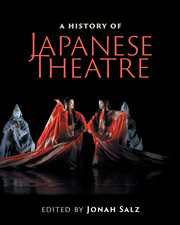Book contents
- Frontmatter
- Contents
- List of figures
- List of tables
- Contributors
- Contributors’ biographies
- Foreword
- Acknowledgments
- Note on Japanese terms
- List of abbreviations
- Timeline
- Editor's introduction
- I Traditional theatres
- Preface to Part I Japanese civilization arises
- II Modern theatres
- Preface to Part II
- 6 Birth of modern theatre: shimpa and shingeki
- Interlude Modern comedies and early musicals
- Interlude Takarazuka: all-girls’ revue and musicals
- 7 Rise of shingeki: Western-style theatre
- Interlude Manzai and Yoshimoto vaudeville comedy
- 8 Wartime colonial and traditional theatre
- Interlude Kami-shibai: picture-card storytelling
- 9 Maturing shingeki theatre
- Interlude Postwar musicals and commercial theatre
- 10 Sixties Theatre
- Interlude Butoh: dance of darkness and light
- 11 Contemporary theatre
- Interlude Tokyo: world theatre capital
- Interlude Charting Tokyo theatre today: 24 November 2012
- Interlude Modern theatre tomorrow: interview with Oriza Hirata
- III Arcs and patterns
- IV Theatre architecture
- Preface to Part IV Evolution of Japanese theatre architecture
- V Theatre criticism
- VI Intercultural influences
- Epilogue: Frozen words and mythology
- Further reading
- Index
- References
Interlude Kami-shibai: picture-card storytelling
from Preface to Part II
Published online by Cambridge University Press: 05 July 2016
- Frontmatter
- Contents
- List of figures
- List of tables
- Contributors
- Contributors’ biographies
- Foreword
- Acknowledgments
- Note on Japanese terms
- List of abbreviations
- Timeline
- Editor's introduction
- I Traditional theatres
- Preface to Part I Japanese civilization arises
- II Modern theatres
- Preface to Part II
- 6 Birth of modern theatre: shimpa and shingeki
- Interlude Modern comedies and early musicals
- Interlude Takarazuka: all-girls’ revue and musicals
- 7 Rise of shingeki: Western-style theatre
- Interlude Manzai and Yoshimoto vaudeville comedy
- 8 Wartime colonial and traditional theatre
- Interlude Kami-shibai: picture-card storytelling
- 9 Maturing shingeki theatre
- Interlude Postwar musicals and commercial theatre
- 10 Sixties Theatre
- Interlude Butoh: dance of darkness and light
- 11 Contemporary theatre
- Interlude Tokyo: world theatre capital
- Interlude Charting Tokyo theatre today: 24 November 2012
- Interlude Modern theatre tomorrow: interview with Oriza Hirata
- III Arcs and patterns
- IV Theatre architecture
- Preface to Part IV Evolution of Japanese theatre architecture
- V Theatre criticism
- VI Intercultural influences
- Epilogue: Frozen words and mythology
- Further reading
- Index
- References
Summary
Kami-shibai (紙芝居, “paper theatre”) is popular visual storytelling theatre. Especially popular from 1930 to 1950, it became a potent, multipurpose media for moral education, propaganda during the war (both nationalist and socialist), useful work for the unemployed, and entertainment for the masses. Today its pretty, elaborate panels, fair-barker promotional style, and avuncular storytelling at nursery schools and kindergartens is a far cry from the risky, street-corner vendors of horror, action, and war tales that flourished before the advent of television.
A former rakugo storyteller invented a sideshow attraction, narrating short dramas using paper dolls of kabuki characters called tachi-e (立絵 “standing pictures”) with miniature stage settings. From the early 1900s to 1920s, various performers, selling sweets, visited children's playgrounds in Tokyo with portable stages and tachi-e doll shows, the genre eventually coming to be known as kami-shibai.
Around 1930, a new type of kami-shibai called hira-e (flat pictures) was invented which employed several illustrated cardboard panels, allowing for quick and smooth progression of scenes, multiple viewpoints, and magnification of details through cinematic “close-ups.” The show could easily be constructed and performed, even by amateurs; selling sweets through hira-e kami-shibai became a ready livelihood for many unemployed people in major cities in the midst of the Shōwa Depression (1930–3).
The majority of kami-shibai stories were serial action-adventures such as Ōgon batto (The golden bat, 1930) or horror stories like Hakaba Kitarō (Kitarō from the cemetery). There were also sentimental melodramas, comedies, and variants on folktales. The daily episode of such serials always ended on a cliffhanger.
Drama delivered
Typically, kami-shibai performers rode bicycles, carrying a wooden frame equipped with a stack of storyboards and drawers holding sweets and other snacks. Visiting parks or alleys where they could attract many children, they announced their presence with wooden clappers. Those buying snacks were given better viewing positions near the front. Scenes proceeded by showing a succession of storyboards; performers not only narrated but impersonated several characters, and even added sound effects using clappers, drums, or hand bells. The hikinuki (pulling out) technique permitted the front storyboard to be partially removed, quickly or slowly, creating suspense or surprise.
The hira-e kami-shibai industry was based on a complicated division of labor. Bosses (kashimoto, the lender) ordered scenarios from writers, then contracted artists to draw appropriate pictures.
- Type
- Chapter
- Information
- A History of Japanese Theatre , pp. 264 - 266Publisher: Cambridge University PressPrint publication year: 2016



